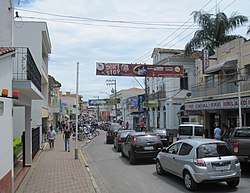Socorro, São Paulo
| Socorro | |||
|---|---|---|---|
| municipality | |||
| Municipality of the Hydromineral Spa of Socorro | |||

A street in downtown Socorro
|
|||
|
|||
 Location in the state of São Paulo |
|||
| Location in the state of São Paulo | |||
| Coordinates: 22°35′29″S 46°31′44″W / 22.59139°S 46.52889°W | |||
| Country |
|
||
| Region | Southeast | ||
| State |
|
||
| Founded | August 9, 1829 | ||
| Incorporated | March 17, 1883 | ||
| Government | |||
| • Mayor | Andre Bozola (PTB) | ||
| Area | |||
| • Total | 448.074 km2 (173.002 sq mi) | ||
| Elevation | 752 m (2,467 ft) | ||
| Population (2012) | |||
| • Total | 37,288 | ||
| • Density | 83/km2 (220/sq mi) | ||
| • Demonym | Socorrense | ||
| Time zone | UTC-3 (UTC-3) | ||
| • Summer (DST) | UTC-2 (UTC-2) | ||
| Postal Code | 13960-000 | ||
| Area code(s) | 19 | ||
| HDI (2000) | 0.812 –high | ||
| Website | Socorro City Hall | ||
Coordinates: 22°35′29″S 46°31′44″W / 22.59139°S 46.52889°W
Socorro is a municipality in the state of São Paulo in Brazil. The city is located on the "do Peixe" River and in Mantiqueira Mountains, bordering the state of Minas Gerais to the north and east. Currently, the city's economy is based in the sector of clothing (knitting), ecotourism and adventure sports.
Socorro was settled in 1738 by Simão Toledo Pizza, after the local indigenous people (Carajás) left the place due to the Bandeirantes incursions. At that time, it was known as Campanha de Toledo (Toledo's Campaign), it belonged to the then-called Sertão de Bragança (Bragança's Countryside) and it had a population of 922. In 1839, a chapel in honor of Our Lady of Perpetual Help was built in the place where today is located the Main Church of the city. The first mass was conducted on August 9, the birthday of the municipality. However, it wasn't until 1883 that it had really become a municipality. In 1889, it became a comarca. In 1945, Fernando Costa, then governor of São Paulo, elevated it to the condition of "Estância Sanitária".
Since the 19th century, the city is an important coffee producer. When the slavery was brought down and the so-called Old Republic begun, Italian immigrants arrived in São Paulo to replace the now-free slaves in the coffee farms. The farmers from São Paulo wanted a railway to more efficiently take their coffee to the ports. As the construction of railways connecting the coast to the countryside started, the Companhia Mogyana de Estradas de Ferro was created, having its first train station inaugurated on March 18, 1872, in Campinas.
...
Wikipedia



